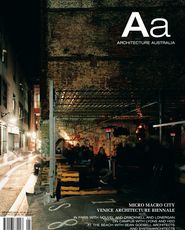Hélène Frichot speaks to Alain de Botton about The Architecture of Happiness.
Roland Barthes’ seminal book The Pleasure of the Text teases out a crucial, though precarious, distinction between jouir and jouissance, or pleasure and bliss. Pleasure, for Barthes, requires an excessive, even sublime moment in the little death of bliss.
What is more radical is that pleasure, and its supreme climax, bliss, can be achieved in the apparently innocent act of reading, especially reading aloud, which involves the whole body. The text can wreak a real corporeal effect. “It granulates, it crackles, it caresses, it grates, it cuts, it comes: that is bliss,” writes Barthes.
Interestingly, Alain de Botton identifies Barthes as a hero and cites The Pleasure of the Text as a precedent for his recent book, The Architecture of Happiness. Pleasure, Botton tells me, can be found in doorknobs and window mullions, brickwork and other such architectural paraphernalia. It seems that the way to happiness in architecture resides in the specifically visual pleasure attained in our response to the thoughtful distribution of the material of the built environment. The genesis of Botton’s investigation lies in the question, what makes a building beautiful and why do we care? And by the end of our exchange Botton admits that the book is not really about happiness at all, but about beauty and the visual. “Perhaps it should have been called The Architecture of Beauty,” his polite, British voice trails off, disconsolate.
Before the centrality of happiness was displaced, I asked Botton whether Gaston Bachelard’s The Poetics of Space had been an inspiration. Bachelard ventures what he calls a topoanalysis of specifically felicitous spaces that he discusses with the use of literary images. Though Botton admitted he liked the idea of Bachelard, he found that he couldn’t read much of him. Likewise, the entire gamut of contemporary architectural theory, in fact, twentieth-century discourse on architecture in general, proved entirely unrewarding. On researching the conceptual conjunction of architecture and happiness, Botton claimed he could find no valuable texts in the architecture section of the library to guide his work. No matter, for beneath what he admits might appear to be a cosy and commonsense surface he prides himself on his original thought. What’s more, he is adamant that The Architecture of Happiness is “secretly” for architects, who will most benefit from its revelations.
As architectural theory had so little to offer him, Botton found he had to retreat to eighteenth-century German Idealism, and yet further to Christian philosophy of the Middle Ages, which, he explained to me, equated beauty with goodness. Thus two philosophical propositions support his argument. First, beauty presents an ideal toward which we can aspire, an ideal that promises a glimmer of happiness that might fill a melancholic chasm we hide in our true selves. Second, the “metaphysical stirrings” aroused by beautiful buildings have the power to improve us “morally and spiritually”; here Botton is very careful to include both Christian and Islamic architectural exemplars. In both instances, though, that which the beautiful inspires in us is a bittersweet sadness, to the detriment of the possibility of any joyful affections or anything approximating Barthes’ jouissance.
One general misconception about Botton should be promptly dispelled. He is not a philosopher. Botton read history at Cambridge (which does not mean he should be forbidden from constructing philosophical problems). What he likes to do is to venture into areas of expertise and forward what he believes to be novel arguments. On the dust jacket of The Architecture of Happiness Botton is described as a “purveyor of serious but playful manuals for living”. And according to Botton, the discipline of architecture is in desperate need of such a manual.
Buildings speak, this is what architects have either forgotten or not yet fully realized. To restore a universal language to architecture, what is needed is a handbook, for “with the aid of such a resource, we might become more conscious readers, as well as writers of our environment”, writes Botton. Although a handbook or an architectural dictionary might not always be able to explain why we find this or that building beautiful, it will guide the architect as craftsperson toward a good understanding of what is well composed, regular and ordinary. A keen student of Barthes’ writings, Botton has realized the importance of the death of the author and the dangers in the myth of the creative genius. Architects, Botton insists, suffer under the terrible weight of having to invent forms that are ever new. Developers and architects who do not adhere to the rules and who try to reinvent the wheel on every street corner should be punished, Botton tells me.
What kind of language is it that buildings speak? In Botton’s opinion, altogether too much contemplation is directed at historical sources and stylistic tropes. What is needed is more anthropomorphic, metaphoric and evocative associations. The most adequate way to describe buildings is by making associations between them and human or other living forms: “lithe athletes” or “a stocky middle-aged man who hoists his trousers”, “upturned insect legs” and the like. To borrow yet again from Barthes, the image-repertoire collected in Botton’s book presents us with nothing more compelling than insipid flowers, rustic floorboards and objects that have come to resemble our favourite aunt. To extend the argument regarding our aptitude for anthropomorphic associations, the reader is taken on a quasiscientific detour through a simplified psychologism that suggests that we read the built environment in much the same way that we would read the people around us.
Good buildings are like “prototypically admirable human beings” and that which we elevate architecturally is whatever we find we lack in ourselves. A childlike game ensues, whereby inanimate objects and built surrounds are artificially brought to life.
To approach architecture Botton has followed several epistemological avenues.
Finally, he appears confused about the nature of the object under investigation – is it mere decoration, sharing the “bathos of gardening”, or does it proffer the potential for the highest forms of happiness? It is difficult to be tough on Alain, especially as he has suffered such a terrible beating from the British press. What’s more, the writer turns out to be the most timid of the creatures hidden away in the folds of this book. The Architecture of Happiness promises so much. The premise is that, with sufficient care, the thoughtful composition of the architecture of our built environment can contribute to our happiness and wellbeing. The book and associated television series, The Perfect Home, have been a popular success. Botton takes aim at the usual culprits – greedy developers, pastiche architecture – but at the same time he makes the complex undertaking of architecture appear straightforward. Botton has written a dangerous work in that it threatens to lull us into a non-critical state of mind wherein we are neither challenged nor provoked to think anew. And who are the final arbiters of what passes as beautiful architecture? The worms and the trees.
As Botton concludes, “We owe it to the worms and the trees that the buildings we cover them with stand as promises of the highest and most intelligent kinds of happiness.” In the end the status quo is maintained, we can all rest easy in our comfortable armchairs, surrounded by the polite restraint of beautiful objects, the walls of our homes closed in around us warding off the dangers of an unruly outside.HÉLÈNE FRICHOT IS A LECTURER IN ARCHITECTURE AT RMIT UNIVERSITY.















